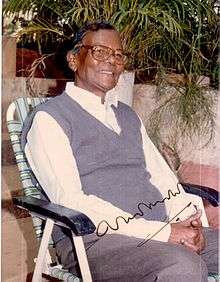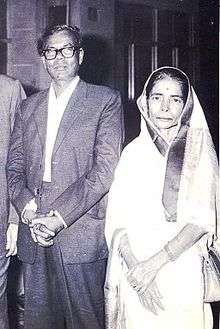Gopinath Mohanty
| Gopinath Mohanty | |
|---|---|
 Gopinath Mohanty at Home in Bhubaneswar in 80s | |
| Born |
20 April 1914 Nagabali, Cuttack |
| Died | 20 August 1991 (aged 77) |
| Nationality | Indian |
| Education | M.A. |
| Alma mater |
Ravenshaw College Patna University |
| Occupation | Administrator, professor |
| Awards |
Jnanpith Award Padma Bhushan |
Gopinath Mohanty (1914–1991), winner of the prestigious jnanpith award, eminent Odia novelist of the mid-twentieth century is arguably the greatest Odia writer after Fakir Mohan Senapati.
Early life and education

He and his older brother, Kahnu Charan Mohanty, along with his nephew Guru Prasad Mohanty exercised tremendous influence on Odia literature for about three decades. Born at Nagabali (a small village on the bank of River Mahanadi which can boast of producing some of the trendsetters in Odia literature be it Gopinath himself, Kahnu Charan and Guru Prasad) in Cuttack district on 20 April 1914, Mohanty received higher education at Ravenshaw College. He got his M.A. degree from Patna University in 1936.
Career
He joined the Odisha Administrative Service in 1938. Most of his service career was spent among the poor tribals of the undivided Koraput district. He retired from government service in 1969. He was UGC Distinguished Visiting Professor and Writer-in-Residence for two years, at the English Department, Utkal University in the late 1970s, invited by Professor Prabhat Nalini Das, Founder-Professor and Head of the English Department, Utkal University. In 1986, he joined San Jose State University in the USA as an Adjunct Professor of Social Sciences. He died at San Jose, California on 20 August 1991.
Novels
Gopinath appeared on the literary scene at Post Independent Age .The vibrant life of people of Odisha, rural as well as tribal, found expression in the works of these writers. In his fiction Gopinath Mohanty explores all aspects of Odishan life: life, both in the plains and in the hills. He evolves a unique prose style, lyrical in style, choosing worlds and phrases from the day-to-day speech of ordinary men and women.
Gopinath’s first novel, Mana Gahirara Chasa, was published in 1940, which was followed by Dadi Budha (1944), Paraja (1945) and Amrutara Santana (1947). He published 24 novels, 10 collections of short stories in addition to three plays, two biographies, two volumes of critical essays, and five books on the languages of Kandh, Gadaba and Saora tribes. Moreover, he translated Tolstoy’s War and Peace (Yuddh O Shanti in three volumes, 1985–86) and Tagore’s Jogajog (trans. 1965) into Odia.
Although Gopinath has tried his hand at various literary forms, it is for his novels that he will be best remembered. “Fiction, I realized, would best suit my purpose," he once said in an interview to Indian Literary Review. He uses the novel to portray and interpret several dimensions of human existence. He draws the material for his writing from his rich experience and transforms it imaginatively into a powerful image of life.
Among his novels, Dadi Budha, Paraja, Amrutara Santana and Aphanca are remarkable for their portrayal of tribal life in the densely wooded hills and forests of the Eastern Ghats. The Kandhas and the Parajas are two colourful and proud tribal communities living in tiny clusters of helmets in the southern parts of Odisha. People of these primitive communities have been exploited by moneylenders and petty government officials of many years. They have felt in their body and bone that exploitation is as old as the hills and forest surrounding them. yet they celebrate the joys of life; they drink and dance and sing; they find joy in nature, in buds and flowers, in green leaves, in the chirping of birds, in the swift- flowing streams and in the mist covered hills. They find life constantly renewing itself in the quick- fading and sloe- blooming buds of the forest.
Dadi Budha (1944) is one of the shorter novels of Gopinath Mohanty. It has the distinction of being his first novel based on tribal life. The novels tells the moving story of the disintegration of a tribal community under the impact of modern civilisation. Dadi Budha is an ancient datepalm tree representing the eternal ancestor; it stands for the cultural heritage of the tribal people manifest in their rituals and costumes. The tree stands as a silent witness to the joys and sorrows of the tribal folk; it dominated the drama of their existence. Close to Dadi Budha stands a termite mound called Hunka Budha, yet another symbol of the primitive and innocent faith of tribal people. Thenga Jani, the son of Ram Chandra Muduli, the headmen of Lulla village, is beteothed to a beautiful girl, Saria Daan, the only daughter of the same village. But he comes under the spell of Sanotsh Kumari, a Christian Domb girl. Thenga and Santosh deeply in love and reject the discipline of the tribal society. They decide to run away to Assam to work on a tea estate; they planned to build their dream home in a town where the rule of the tribal society does not prevail. Gopinath visualises life tribal community against a cosmic background. The despair of Ram Muduli, the plight of Thenga mother after her only son leaves the village with the Domb girl, the declaration of the dishari that Thenga and Santosh were evil dumas, the terror caused by the tiger and the rise of a village at another site all these signify the unbroken continuity of life.
Paraja (1945) tells us a different based on the life of the same community. It is the tale of one’s attachment to land, the soil of one’s ancestors. Sitakant Mahapatra describes the novel as " the story of shattered dreams".[1] In Dadi Budha , the old order changes the yielding place to the new; in Paraja the intrusion of brutality in the guise of civilised law generates resentment and violence. Amrutara Santana (1947), the first Indian novel to receive the Sahitya Akademi Award(1955), is centred round the life of Kandhas, another tribe in the southern parts of Odisha. The novel depicts the grandeur of living and the intensity of suffering or the tribal people. Gopinath Mohanty has himself said that his most important work was Amrutara Santana .
Gopinath's fictional world is not confined to the tribal people. He has also written about the people living in the coastal plains. Even when he shifts his focus from the hills to the plains, he retains his deep concern for the oppressed and underprivileged. His novel, Harijan (1948), deals with untouchables living in slums and their brutal exploitation by the rich. Danapani (1955) presents the grey world of a colourless middle class, petty and mean, and full of gossip and rumours. Laya Bilaya (1961) explores the psychological complexity of three members of a family from Calcutta on a short tripp to Puri. Matimatala (1964), a novel of epic dimension based on life in rural Odisha, celebrates the eternity of love. In this novel, he successfully brings about a fusion of two worlds: the private world of lovers and the public world of social workers. Gopinath’s language is remarkable for its subtlety and its poetic quality. Characters and landscapes come vividly to life in his novels through nuance and evocative descriptions. His language has a unique lyrical grace.
Short stories
In the Post-Independence Era Odia fiction assumed a new direction. The trend which Fakir Mohan Senapati has started actually developed more after 50s of last century. Gopinath Mohanty, Surendra Mohanty and Manoj Das are considered as three jewels of this time. They are the pioneer of a new trend, that of developing or projecting the "individual as protagonist" in Odia fiction. Eminent Feminist writer and critics Sarojini Sahoo believes that it was not Gopinath, but Surendra Mohanty whose "Ruti O Chandra" has to be considered as first story of individualistic approach rather than the story "Dan" by Gopinth, which was formerly known as the first story of "individualistic attitude".[2] He published 10 collections of short stories in addition to 24 novels, three plays, two biographies, two volumes of critical essays, and five books on the languages of Kandh, Gadaba and Saora tribes. Moreover, he translated Tolstoy's War and Peace (Yuddh O Shanti) in three volumes, (tr. 1985–86) and Togore's Jogajog (tr. 1965) into Odia. In his short stories Gopinath Mohanty explores all aspects of Odishan life: life, both in the plains and in the hills. He evolves a unique prose style, lyrical in style, choosing worlds and phrases from the day-to-day speech of ordinary men and women.
Gopinath’s novels in English
Four of Gopinath’s novels,Paraja, Danapani, Laya Bilaya and Dadi Budha, have appeared in English translation. The first three have been translated by Bikram K. Das, and the last mentioned one of Arun Kumar Mohanty. The English version of Paraja was published by Faber and Faber (UK) and Oxford University Press (India) in 1987.The Survivor, the English translation of Danapani, was published by Macmillan India Limited in 1995. The translation of Laya Bilaya which bears the title, High Tide, Ebb Tide, has been published by Lark Books. . The Ancestor, the translation of Gopinath’s Dadi Budha, has been brought out by the Sahitya Akademi. Besides, a number of short stories of Gopinath have also been translated. It is extremely difficult to render in English the nuances of Gopinath Mohanty’s language. However, translators have attempted to convey the richness and complexity of the original texts to readers unfamiliar with Odia.
Tribal life in Gopinath’s novels
In his portrayal of tribal life, Gopinath Mohanty invites comparison with the Nigerian novelist, Chinua Achebe. At one level, their visions are almost identical: they visualise the disintegration of a primitive community under the impact of a new faith or an alien value-system. But to see the disintegration of Lulla village (In the novel, Dadi Budha) and the tribal community in Umuofia (In Things Fall Apart) as parts of the same process of change is to play down the role of colonialism as an agent of disruption. Achebe’s allusion to W.B. Yeats is not a gesture of submission; it interrogates its cosmic, universalist vision of change. Although Gopinath does not directly refer to Yeats, he also focuses the traumatic expression of colonialism in his work.
Awards
He received the Visuva Milan citation in 1950. He won the central Sahitya Akademi Award in 1955 for his novel, Amrutara Santan.The Jnanapith Award was conferred on him in 1973 for his epic-prose "Mati Matala" (The Fertile Soil). He was awarded the Soviet Land Nehru Award in 1970 for his Odia Translation of Gorky's work, the D. Litt. Degree by Sambalpur University in 1976 and a Fellowship for Creative Writing in Odia by the U.G.C. in 1979. In 1981, the government of India conferred on him Padma Bhushan in recognition of his distinguished contribution to literature. He was an Emeritus Fellow of Government of India for creative writing. He was conferred with:
- Padma Bhushan in recognition of his distinguished contribution to literature by Government of India, 1981
- Jnanpith Award, 1973[3]
- Sahitya Akademi Award, 1955,
- Orissa Sahitya Academy Award, 1993,
- Soviet Land Nehru Award in 1970,
- Fellowship for Creative Writing in Oriya by the U.G.C. in 1979 and
- D. Litt. Degree by Sambalpur University in 1976
See also
References
- ↑ reaching the other share, Delhi; B.R. publication, 1992 P.33
- ↑ Istahar-92, (26th Volume, 2nd Issue)
- ↑ "Jnanpith Laureates Official listings". Jnanpith Website.